- Policy
- TCFD
- Governance
- Strategy
- Risk Management
- Metrics and Targets
- Risks and Opportunities
- Initiatives
- Data
Policy
In 2020, the Oji Group formulated its Environmental Vision 2050 centered around the goal of net-zero carbon emissions, while also positioning the Environmental Action Program 2030 as a milestone toward achieving its medium-term targets. In 2025, we established the "Environmental Action Program 2040" as new targets to further advance our initiatives. To achieve the target of reducing net greenhouse gas (GHG) emissions by 70% compared with FY2018 levels by FY2030, and reaching net zero by FY2040, we are working to reduce actual emissions by reducing coal consumption and other emission sources and increasing the net increment in carbon stocks in forests we own and manage.
Business Model Targeting Decarbonization
The Oji Group engages in a wide array of business activities, including the manufacture of pulp and paper. In light of the substantial amounts of heat (steam) and electricity consumed, these activities accordingly lead to the emission of GHGs commensurate with this energy use. By working to reduce GHG emissions from energy use and facilitating the absorption of CO2 by forests that we own and manage, we are contributing to climate change mitigation.
Pulp and paper mills generate steam and electricity from black liquor produced in the wood pulp manufacturing process and waste wood unsuitable for use in pulp raw materials. The CO2 emitted during combustion is offset by the CO2 absorbed by trees during growth. In addition, the waste heat (steam) after generating electricity is reused in the manufacturing process to more effectively use energy. Moreover, steps are taken to utilize the electricity generated by Chitose No. 1 Hydroelectric Power Plant in Hokkaido, a facility that began operating in 1910, as well as the solar power systems on factory roofs.
In addition to practicing sustainable forest management through replanting following harvesting, as well as the planting of elite trees with high growth rates, every effort is made to maintain and facilitate forests’ ability to absorb CO2.
In addition to on-site consumption at our mills and factories, renewable energy derived from biomass, hydropower, and solar power is also supplied externally through our energy business. We also plan a wind power generation project on company-owned land. Through these renewable energy initiatives, we contribute to climate change mitigation by helping reduce the indirect GHG emissions of electricity consumers.

TCFD
The Oji Group announced its support for the Task Force on Climate-related Financial Disclosures (TCFD*1) in December 2020 and has since been working to disclose climate-related information as recommended by the TCFD.
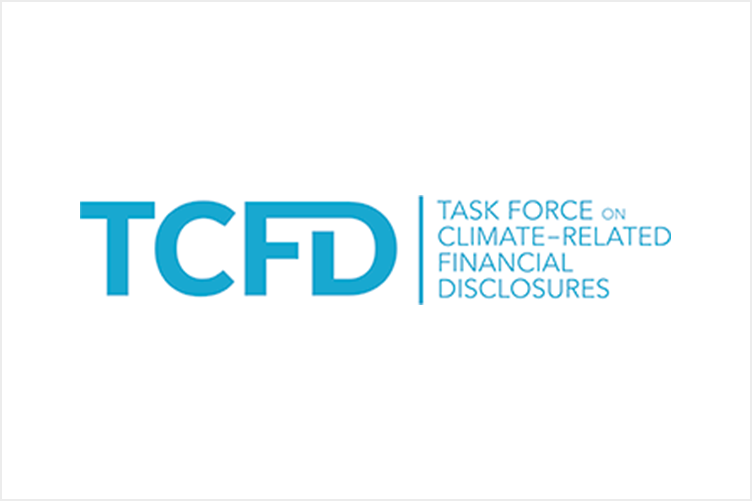
- *1 The TCFD is a task force established by the Financial Stability Board (FSB) as requested during a G20 Finance Ministers and Central Bank Governors Meeting. In June 2017, the TCFD released its recommendations that encourage companies to disclose the financial implications of climate-related risks and opportunities to help investors make appropriate investment decisions.
Governance
Climate-related risks, opportunities, and responses of the Oji Group are discussed by the Sustainability Committee under the supervision of the Board of Directors of Oji Holdings. For further details, please refer to the Sustainability Management Structure page.
Strategy
The climate-related risks and opportunities that the Oji Group faces have been analyzed. We recognize the importance of transition risks due to policies and regulations such as carbon taxes in the medium term as we move toward 2030, physical risks such as changes in precipitation and weather patterns in the long term as we move toward 2050, and the opportunities regarding the increased demand for low-carbon products in the medium to long term. Regarding the cost increase attributable to carbon pricing mechanisms such as carbon taxes, we estimate the impact to be approximately 68 billion yen for FY2030. This calculation is based on the projected CO2 emissions from fossil fuels in that year, multiplied by the carbon price of 140 USD/t-CO2, as set out in the Net Zero Emissions (NZE) scenario for 2030 in advanced economies by the International Energy Agency (IEA). For details on risks and opportunities, please refer to the table presented later on this page.
To address these risks and opportunities, the Oji Group is working to transition its business structure, improve energy efficiency in manufacturing and transportation, expand the use of non-fossil energy sources, and enhance CO2 absorption and sequestration through forest conservation and afforestation. These efforts support the transition to a decarbonized society, with the aim of reducing net GHG emissions by 70% by FY2030 and achieving net zero carbon emissions by FY2040. In preparation for potential deterioration in tree growth due to changes in precipitation and weather patterns, we are strengthening stable procurement through diversified sourcing and engaging in the development and selection of tree species suited to specific climates and regions. Furthermore, we are advancing the development of new wood-based materials that contribute to decarbonization. We plan to invest 100 billion yen in reducing coal consumption and another 100 billion yen in acquiring overseas forest plantations by FY2030. While continuing our present efforts to limit the negative impact of the transition to a decarbonized society on our business, we will continue to analyze risks and strengthen our climate resilience.*2
- *2 The climate resilience concept involves organizations developing their ability to adapt to climate change to better manage the associated risks and seize opportunities, including the ability to respond to transition risks and physical risks. (Source: TCFD recommendations)
GHG Emissions Reduction Roadmap
To achieve our FY2030 and FY2040 targets, we are focused on reducing actual emissions and increasing the net increment in carbon stocks in forests.
Of the 16 boilers in Japan that were burning coal as of FY2018, we will terminate the operation of all eight boilers that are fired only by coal by FY2030, excluding backup boilers, and we will switch to gas fuels during the transition phase as we move toward decarbonization. The operation of two boilers was discontinued by FY2024. Plans are in place to discontinue the use of two Oji Materia Co., Ltd. boilers by FY2027, one at its Sobue Mill and one at its Saga Mill. We are also considering reducing coal consumption by changing the composition of the fuels used in coal co-fired boilers.
The plan at the Sobue and Saga Mills is to replace the boilers that only burn coal by installing gas cogeneration systems whose GHG emissions per unit of output energy will be lower than the technical screening criterion of 270 g-CO2/kWh set by the EU Taxonomy.*3
- *3 The EU Taxonomy is a classification system established by the European Union to identify environmentally sustainable economic activities. Gas cogeneration systems that meet the criteria are defined as a transitional activity moving towards a climate-neutral economy that contributes to the mitigation of climate change.
Further reducing the use of fossil fuels, including gas, is essential for achieving net-zero carbon emissions in FY2040. To this end, we are considering the use of alternative fuels, including hydrogen, ammonia and e-methane (synthetic methane). We are also decarbonizing purchased electricity by changing contract terms and utilizing non-fossil certificates, with the goal of achieving a 100% non-fossil electricity ratio.
Moreover, to increase the net increment in carbon stocks, we are advancing efforts to acquire overseas forest plantations. Making the most of the tree breeding and forest plantation technologies nurtured over the many years that we have been operating, we are engaging in the cultivation of elite fast-growing trees best suited to each region. Moving forward, we are facilitating the absorption of CO2 while expanding forests with a high net increment in carbon stocks.
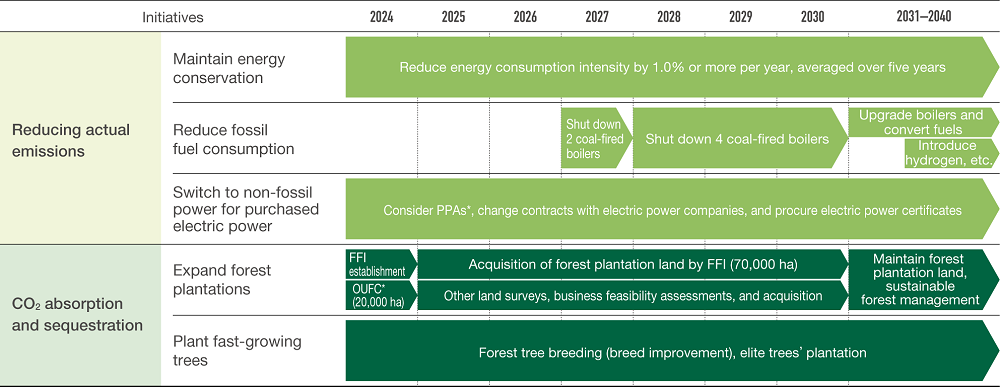
Risk Management
The Corporate Sustainability Division examines risks on a Group-wide basis with assistance from external experts, and the Sustainability Committee analyzes them while discussing their importance and prioritizing them. The impact of these risks on our businesses, strategies and finances are assessed quantitatively and qualitatively, using 1.5 °C (2 °C) and 4 °C scenarios for the medium term (2030) and the long term (2050).*4 The Corporate Sustainability Division is in charge of the overall management of the responses to climate-related risks built upon the Group-wide strategy, and the Sustainability Committee manages the progress of these initiatives. Specifically, to reduce GHG emissions, we have organized a project team and are working to reduce coal consumption and expand the net increment in carbon stocks in forests. Furthermore, climate-related risks are reported to the Group Management Meeting and referred to the meeting for discussion depending on their importance, and they are integrated into company-wide risk management activities.
- *4 Transition risks were analyzed using two scenarios: The IEA’s 2 °C Scenario (IEA 2DS) that shows a pathway to possibly limiting global warming to 2 °C, and the Net Zero Emissions by 2050 Scenario (NZE 2050) that looks at the achievement of net zero CO2 emissions by 2050. Physical risks were analyzed using the RCP 1.9, RCP 2.6, and RCP 8.5 scenarios. In RCP 8.5, the average global temperature is projected to rise by more than 4 °C and natural disasters are expected to become more frequent.
Metrics and Targets
We have set the following targets in accordance with the 1.5 °C target of the Paris Agreement. The carbon price of 140 USD/t-CO2 (2030 level in developed countries) in the International Energy Agency (IEA)’s Net Zero Emissions (NZE) scenario is used as the internal carbon price (ICP) for risk analyses and the evaluation of investment decisions.
| Metrics | Targets | FY2024 Results |
|---|---|---|
| Scope 1 + 2 Emissions | ・Reduce net emissions by 70% by FY2030 ・Achieve net-zero emissions by FY2040 (including net increment in carbon stock through forests) |
・Net emissions: 34.2% reduction ・Gross emissions: 11.9% reduction ・Net increment in carbon stock: Equivalent to 22.4% reduction |
| Scope 3 Emissions | ・Reduce emissions from chip transport vessels by 40% by FY2040 (part of Category 4) |
・Emissions from chip transport vessels: 33.6% reduction |
| Coal Consumption | ・Eliminate coal consumption by FY2040 | ・Coal consumption: 18.9% reduction |
Our target is to reduce net emissions (actual emissions minus the net increment of carbon stocks) by at least 70% compared to the FY2018 level by FY2030. We will achieve 20% of this by reducing actual emissions (total Scope 1 and 2 emissions), and the remaining 50% by increasing the net increment in carbon stocks of forests. Regarding the target of achieving net zero emissions by FY2040, we will reduce actual emissions by 50% and sustain the net increment in carbon stocks at a level equivalent to 50% of FY2018 emissions.
In FY2024, we reduced net GHG emissions to 5,156 kt-CO2, a 34.2% reduction compared to FY2018.
We have set a target to reduce emissions from wood chip carriers, which fall under Category 4 (Upstream Transportation) of Scope 3, by 40% compared with the FY2018 level by FY2040. In FY2024, emissions were reduced by 33.6%.
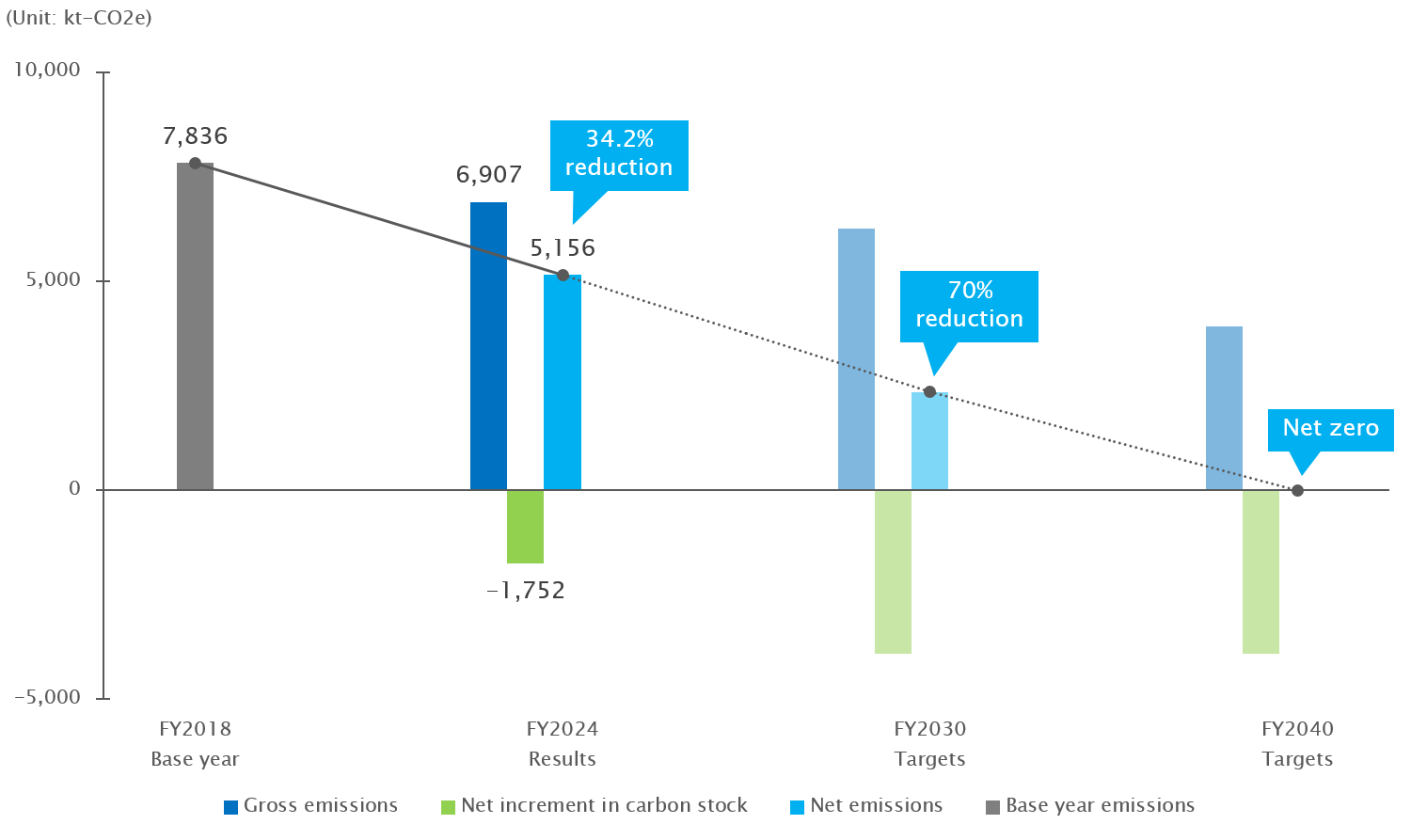
Risks and Opportunities
- * This table can be viewed by scrolling horizontally.
|
Type
|
Driver
(Factor causing an impact on our business) |
Awareness of business environment
|
Impact on our business |
Strategies and countermeasures
|
||||
|---|---|---|---|---|---|---|---|---|
| 1.5℃ (2℃) scenario | 4℃ scenario | |||||||
| 2030 | 2050 | 2030 | 2050 | |||||
|
Transition risks
|
Policies, laws and regulations | Fluctuation of fossil fuel-derived energy prices | Increase in costs related to procurement using fossil fuel-derived energy and electricity due to changing energy mix | Small | Small | Small | Small |
|
| Tightened CO2 emissions regulations | Increase in energy consumption and credit operating costs due to the Enhance the operation of renewable energy sources such as hydro and biomass energy toward net zero carbon emissions in FY2050 introduction of carbon tax and tightening of regulations on emissions trading | Large* | Small* | Medium* | Small* | |||
| Markets | Increasing stakeholders’ interest in low-carbon products and services | Increase in boycott activities toward products and services created using energy derived from fossil fuels due to increased awareness of decarbonization among consumers | Small | Small | Small | Small |
|
|
| Reputation | Negative feedback from stakeholders |
|
Medium | Medium | Small | Small |
|
|
|
Physical risks
|
Acute | Increasing severity of extreme weather events | Business stagnation such as facilities affected by and supply chain disruptions caused by a large scale natural disaster | Small | Small | Small | Small |
|
| Chronic | Changes in precipitation and weather patterns, and rising average temperatures | Increase in procurement costs primarily as a result of deterioration of growth conditions for trees, key raw materials for our products | Small | Small | Large | Large |
|
|
|
Opportunities
|
Resource efficiency | Effective resource utilization Reduction in water use and consumption |
Increase in demand for advanced water treatment technology and water management due to flooding, drought, precipitation fluctuations, and higher demand for clean water in water stress areas | Small | Small | Medium | Medium |
|
| Energy sources | Use of low emission sources of energy | Increase in demand for renewable energy toward realization of a decarbonized society | Small | Medium | Small | Small |
|
|
| Products and services |
|
Increase in demand for low-carbon and environmentally-friendly products due to increased awareness of decarbonization and environment | Large* | Large* | Large* | Large* |
|
|
| Markets | Use of incentives |
|
Small | Medium | Small | Small |
|
|
- * Note: Impact amount Small: less than 10 billion yen; Medium: not less than 10 billion yen but less than 50 billion yen; Large: not less than 50 billion yen
Impact levels without an asterisk (*) represent qualitative assessment.
Initiatives
Reducing Actual Emissions
We are working to improve energy efficiency and increase the percentage of renewable energy used to reduce the GHG emissions of our business activities. In FY2024, we reduced actual GHG emissions (Scope 1+2) to 6,907 kt-CO2e, which is a 11.9% reduction compared to FY2018.
Energy Management System
At our mills and plants, the energy management and production departments hold regular energy conservation meetings. At the energy conservation meetings, energy-saving targets are set and plans are made to update equipment and improve operations (Plan). These plans are then implemented to achieve the targets (Do). Furthermore, progress and effectiveness are reviewed (Check), and measures are revised as necessary (Act), thereby promoting continuous reduction in energy consumption.
KANZAN's Neumühl plant and Walki's Valkeakoski, Pietarsaari and Steinfurt plants have obtained third-party certification of their ISO 50001 energy management systems.
Improving Energy Efficiency
In FY2024, our major domestic companies invested ¥1.36 billion yen in energy conservation, thereby reducing energy consumption by 39.6 thousand kL (in crude oil equivalent). Across the entire group, energy consumption intensity was reduced by 7.1% per year on average between FY2020 and FY2024.
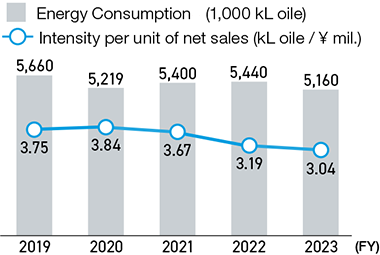
Increasing the Percentage of Renewable Energy Used
Utilizing black liquor, which is a byproduct of the pulp production process, and other biomass fuels, the Oji Group has increased the percentage of its energy consumption that comes from renewable sources. To further expand the use of renewable energy, we are using private hydroelectric power plants and moving forward with the installation of solar power generation systems.
In FY2024, 56.4% of the energy used was renewable energy.
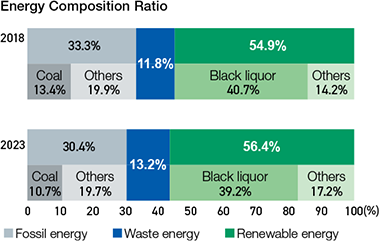
Reducing Coal Consumption
We shut down a coal boiler at Oji Materia Nayoro Mill in FY2021 and another one at Oji F-Tex Ebetsu Mill in FY2023. This decreased coal consumption by 18.9% in FY2024 compared to FY2018. Looking ahead, we will continue to reduce coal consumption, and we project that capital investments of approximately ¥100 billion will reduce GHG emissionsby roughly 1,000 kt-CO2e.
Topic: Indirect reduction of GHG emissions in the Renewable Energy Power Generation Business
In FY2024, we sold 1,504 GWh of electricity generated by biomass, hydropower and solar power through the feed-in tariff (FIT) system for renewable energy. Through this system, electric utilities purchase electricity generated from renewable energy sources at a fixed price. This is equivalent to a 636 kt-CO2e reduction in electricity consumers’ emissions.
- Note:The reduction is estimated assuming that the electricity sold via the FIT system indirectly reduces the CO2 emissions of the users of that electricity. Implied reduction = FIT electricity sales × national average emission factor
FIT electricity sales: The amount of biomass, hydroelectric, and solar electricity generated sold via the FIT system by the Group companies in Japan.
National average emission factor: An emission factor used in the calculation of the equivalent amount of CO2 emissions reduced by using non-fossil electricity under the Greenhouse Gas Emissions Calculation, Reporting and Disclosure System.
Reducing Emissions from Wood Chip Carriers
Most of the wood chips used as raw materials for paper are transported by ship from overseas plantations. With international efforts underway to reduce GHG emissions from ships, the Oji Group’s chip carriers now navigate at lower speeds to increase fuel efficiency and reduce GHG emissions. In addition, the GHG emissions from vessels built in recent years are lower than conventional vessels, contributing to the reduction of GHG emissions.

Installing Solar Power Systems
We have been installing solar power systems on factory roofs and idle land. A warehouse built in August 2022 at Oji Nepia Edogawa Factory uses electricity generated from solar power. In October 2023, the solar power generation system at Oji Container Tochigi Plant began operation, supplying all the electricity used at the plant during the daytime.
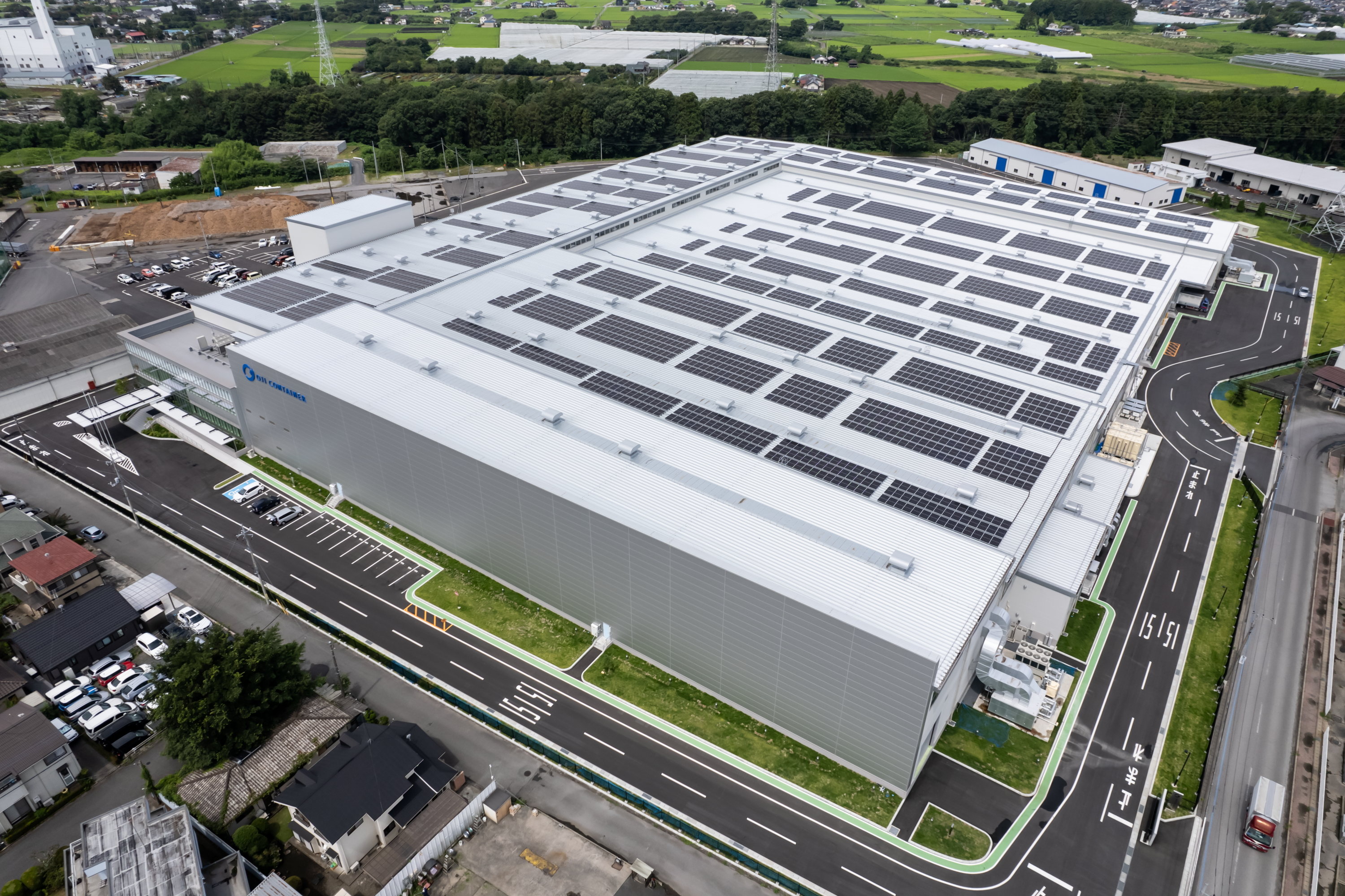
Expansion of Net Increment in Carbon Stocks of Forests
We are expanding the net increment in carbon stocks of forests by expanding plantations and planting fast-growing trees. In the 636,000 ha of forests owned and managed by the Oji Group in Japan and overseas, actual carbon stocks reached 142,020 kt-CO2 at the end of FY2024, and the annual average net increment in carbon stocks of forests between FY2020 and FY2024 was 1,752 kt-CO2.*6 The amount of O2 released during the same period averaged 1,274 kt per year.*7
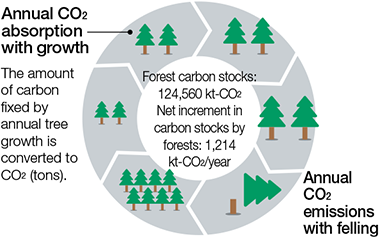
- *6 The figures for carbon stocks and net increment in carbon stocks exclude those of CENIBRA’s forests planted by third parties and forests where it has been less than two years since they were planted.
- *7Calculated assuming that the amount of O2 released is the same as the CO2 absorbed (in moles)
Forest carbon stocks: The CO2 stocks of Oji Forests
Net increment in carbon stocks of forests: The amount of CO2 absorbed by the trees in Oji Forests minus the amount of CO2 stored in the trees felled, which is considered as emissions.
Expand Forest Plantations

Recognizing that the amount of CO2 absorbed by trees is proportional to their growth, production forests with abundant trees in a growth phase absorb more CO2 compared to conservation forests where trees have matured. The Oji Group is expanding its overseas production forests and increasing the number of trees in a growth phase in a bid to increase the net increment in carbon stocks. In July 2024, we acquired 20,000 ha of production forest in Uruguay, expanding the area of overseas production forests from 237,000 ha as of the end of FY2018 to 295,000 ha as of the end of FY2024. Moving forward, through initiatives such as Future Forest Innovations (FFI), a forest investment fund established in March 2025, we are considering acquiring more sites for forest plantations primarily in South America, Oceania, and Southeast Asia, where we have been operating our forest plantation business. Our target is to expand the area of our overseas production forests to 400,000 ha by FY2030, at an estimated acquisition cost of about ¥100 billion.
Plant fast-growing trees
Asia Agriculture and Forestry Technology Center and CENIBRA (Brazil) have long been breeding forest trees. In selecting and planting high-quality varieties, distinguished by their high growth rate and pulp productivity obtained through artificial pollination, efforts are being made to increase the amount of forest growth while facilitating carbon absorption and storage.